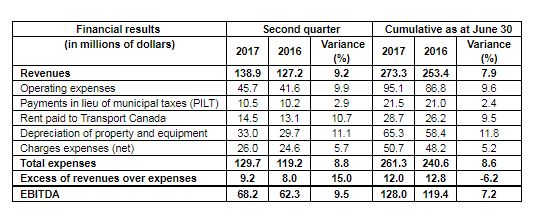Estimated reading time 5 minutes, 3 seconds.
Aéroports de Montréal (ADM) announced its consolidated operating results for the three- and six-month periods ended June 30, 2017. These results are accompanied by data on passenger traffic at Montreal-Trudeau International Airport.
Highlights
Montreal-Trudeau’s passenger numbers reached new highs in comparison with the corresponding periods last year, with 4.4 million passengers enplaned/deplaned during the second quarter of 2017, an increase of 11.0 per cent, and 8.5 million for the half-year ended June 30, 2017, up 8.6 per cent. All three sectors–domestic, transborder (U.S.) and international–contributed to this sustained performance.
EBITDA (excess of revenues over expenses before financial expenses and depreciation of property and equipment) totalled $68.2 million for the second quarter of 2017, a rise of $5.9 million, or 9.5 per cent, over the corresponding period of 2016. EBITDA for the half-year ended June 30, 2017, stood at $128.0 million, up $8.6 million, or 7.2 per cent, from the prior-year period.
The corporation invested $60.0 million in the second quarter and $90.5 million for the first six months of 2017, against $56.6 million and $94.1 million, respectively, in 2016. Investments in the airports were financed by cash flows from operating activities, including airport improvement fees.
Financial results
Consolidated revenues amounted to $138.9 million for the second quarter of 2017, an increase of $11.7 million, or 9.2 per cent, over the same quarter of 2016. Cumulative consolidated revenues for the six months ended June 30, 2017, rose by $19.9 million, or 7.9 per cent over the same period a year earlier, from $253.4 million in 2016 to $273.3 million in 2017. This improvement is mainly attributable to the growth of passenger traffic and higher revenues generated by commercial activities.
Operating costs for the quarter under review were $45.7 million, up $4.1 million, or 9.9 per cent, from the same period of 2016. Operating costs for the half-year ended June 30, 2017, were up by $8.3 million, or 9.6 per cent, over the same period of last year, from $86.8 million to $95.1 million. This variance is attributable to, among other factors, increased operating costs related to the opening of the international jetty expansion in May 2016, as well as to winter conditions and Transport Canada security requirements with the addition of four non-passenger screening-vehicle (NPS-V) checkpoints.
Transfers to governments (payments in lieu of municipal taxes [PILT] and rent paid to Transport Canada) totalled $25.0 million for the second quarter of 2017 and $50.2 million for the first six months of the year ($23.3 million and $47.2 million, respectively, for 2016), representing more than 18 per cent of the corporation’s total revenues.
Depreciation of property and equipment was $33.0 million for the quarter, an increase over the prior-year period of $3.3 million, or 11.1 per cent. Depreciation of property and equipment reached $65.3 million for the six months ended June 30, 2017, a rise of $6.9 million, or 11.8 per cent, over the first half-year of 2016. This rise is mainly attributable to the commissioning of projects completed during 2016, including the expansion of the international jetty in May 2016.
Financial expenses were $26.0 million for the quarter under review, an increase of $1.4 million, or 5.7 per cent, over the same 2016 period. Cumulative financial expenses for the six-month period ended June 30, 2017, rose by $2.5 million, or 5.2 per cent, to $50.7 million, an increase due mainly to higher financial expenses following the issue of Series N bonds in April 2017.
The quarter ended June 30, 2017, produced an excess of revenues over expenses of $9.2 million, compared with $8.0 million for the corresponding 2016 quarter, an increase of $1.2 million, or 15.0 per cent. The cumulative excess of revenues over expenses for the six months ended June 30, 2017, was $12.0 million, against $12.8 million for the first half-year of 2016, a decrease of $0.8 million, or 6.2 per cent.

EBITDA is a financial measurement that is not recognized by International Financial Reporting Standards (IFRS) and is therefore unlikely to be comparable to similar measures used by other entities that are not airports. EBITDA is defined by the corporation as the excess of revenues over expenses before financial expenses and depreciation of property and equipment.
EBITDA is used by management as an indicator to evaluate ongoing operational performance. It is meant to provide additional information and should not be considered as a substitute for other performance measurements prepared in accordance with IFRS.
Passenger traffic
Total passenger traffic at Montreal-Trudeau for the second quarter of 2017 was up by 11.0 per cent, to 4.4 million passengers enplaned/deplaned. International traffic rose by 17.5 per cent, domestic traffic by 7.6 per cent, and transborder (U.S.) traffic by 6.8 per cent over the year-earlier quarter.









